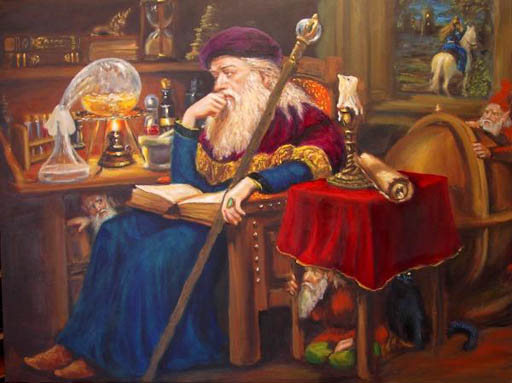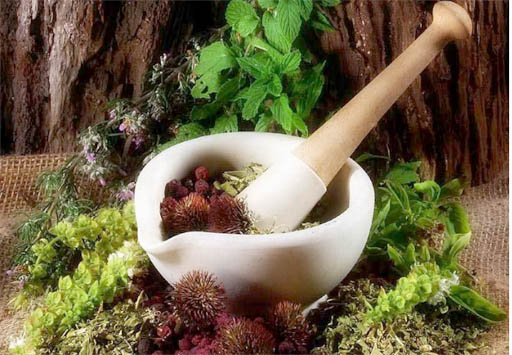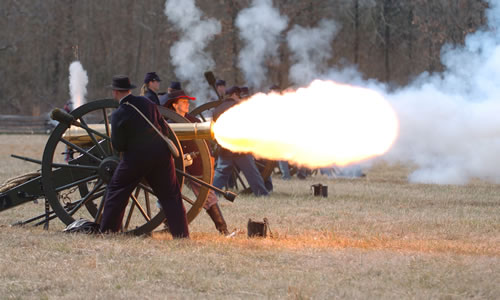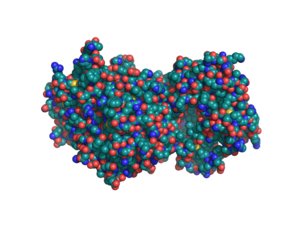SURVIVING THE PITFALLS OF LEARNING CHEMISTRY QUIZ
Instructor, Ken Costello |
|
There are three main pitfalls in learning a difficult subject. New words and new symbols are the first thing you usually trip on. The first word that gives students a problem is on the front cover of your chemistry book. It's the word "Chemistry". I believe people do not really know what a word means until they actually know where it comes from. "Chemistry" is one of those words. Chemistry came from the word, chemist, which came from alchemist, which came from alchemy, which came from the Arabic word, al-kemia. "Al" means "The" and "kemia" means the black lands of Egypt (rich lands along the Nile). Egyptians were obsessed with eternal life and when they heard about Aristotle's fifth element which could turn metals into gold and be a fountain of youth, they pursued that quest. So the art of alchemy was named after the region they lived in (the al-kemia=black lands of Egypt). Also, the Greek word, khymeia, meant the medicinal use of plant extracts. So both words reinforced the idea that alchemy was an activity to find cures or create riches by investigating the substances around us. Even modern chemistry has those goals.
Question #1: In the above paragraph, I used the name "Aristotle." That could have been a misunderstood word for you. So who was Aristotle? |
|
Symptom: A Feeling of Disliking the Subject
Cause: Misunderstood Words and/or Symbols
Question 2: Pick a subject or class that you have had before that you disliked. Tell me a word used in that subject or class that you don't know then and still don't know now what it meant.
|
Below is probably the longest chemical name to be printed in a scientific journal (almost 2,000 characters). It is the full name of the protein "tryptophan synthetase". (It's written below) As its name implies, this protein is somehow involved in the synthesizing of "tryptophan," which is an amino acid. By the way, the tryptophan amino acid is found in turkey meat protein and is commonly blamed for inducing sleepiness after Thanksgiving dinner.
The full name gives the sequence of amino acids that make up the Tryptophan Synthetase protein.
It has 267 amino acids. The first amino acid is indicated with "methionyl" which means methionine, the first amino acid in the chain. When "ine" is removed and "yl" is put in its place that means that methionine is attached to another amino acid. So the two letters "yl" is a sign of where one amino acid ends and another begins. The only exception I see now is "phenyl". "phenyl" always precedes "alanyl" because the amino acid is "phenylalanine". Phenylalanine it is found in the sweetener "Aspartame" (brand name Equal). When you look at something like this 2,000 character chemical name below, it is intimidating and you are likely to turn on the symptoms you get from misunderstood words. However, just stay calm and draw from what you do know. In this case you now know that "yl" can be changed to "ine" to get the name of the amino acid (at least in most cases). Question 3: The smallest amino acid is glycine. Find the first occurence of the glycine amino acid in the long name below. What is the name of the amino acid that comes after it? |
| methionylglutaminylarginyltyrosylglutamylserylleucylphenylalanylalanylglutaminylleucyllysylglutamylarginyl lysylglutamylglycylalanylphenylalanylvalylprolylphenylalanylvalylthreonylleucylglycylaspartylprolylglycylisol eucylglutamylglutaminylserylleucyllysylisoleucylaspartylthreonylleucylisoleucylglutamylalanylglycylalanylaspartyl alanylleucylglutamylleucylglycylisoleucylprolylphenylalanylserylaspartylprolylleucylalanylaspartylglycylprolyl threonylisoleucylglutaminylasparaginylalanylthreonylleucylarginylalanylphenylalanylalanylalanylglycylvalylthreonyl prolylalanylglutaminylcysteinylphenylalanylglutamylmethionylleucylalanylleucylisoleucylarginylglutaminyllysyl histidylprolylthreonylisoleucylprolylisoleucylglycylleucylleucylmethionyltyrosylalanylasparaginylleucylvalylphenyl alanylasparaginyllysylglycylisoleucylaspartylglutamylphenylalanyltyrosylalanylglutaminylcysteinylglutamyllysylvalyl glycylvalylaspartylserylvalylleucylvalylalanylaspartylvalyl prolylvalylglutaminylglutamylserylalanylprolylphenylalanyl arginylglutaminylalanylalanylleucylarginylhistidylasparaginyl valylalanylprolylisoleucylphenylalanylisoleucylcysteinyl prolylprolylaspartylalanylaspartylaspartylaspartylleucylleucylarginylglutaminylisoleucylalanylseryltyrosylglycyl arginylglycyltyrosylthreonyltyrosylleucylleucylserylarginylalanylglycylvalylthreonylglycylalanylglutamylasparaginyl arginylalanylalanylleucylprolylleucylasparaginylhistidylleucylvalylalanyllysylleucyllysylglutamyltyrosylasparaginyl alanylalanylprolylprolylleucylglutaminylglycylphenylalanylglycylisoleucylserylalanylprolylaspartylglutaminylvalyllysyl alanylalanylisoleucylaspartylalanylglycylalanylalanylglycylalanylisoleucylserylglycylserylalanylisoleucylvalyllysylisol eucylisoleucylglutamylglutaminylhistidylasparaginylisoleucylglutamylprolylglutamyllysylmethionylleucylalanylalanylleucyl lysylvalylphenylalanylvalylglutaminylprolylmethionyllysylalanylalanylthreonylarginylserine |
| Pitfall 2: Lack of Reality of the subject. If you were studying proteins and all you looked at were these long names, you would definitely start to exhibit some negative feelings. Also, to you proteins would just seem like a long bunch of words with a lot of yl's in it. Question 4: What are some of the symptoms that comes with learning a subject with a lack of reality? |
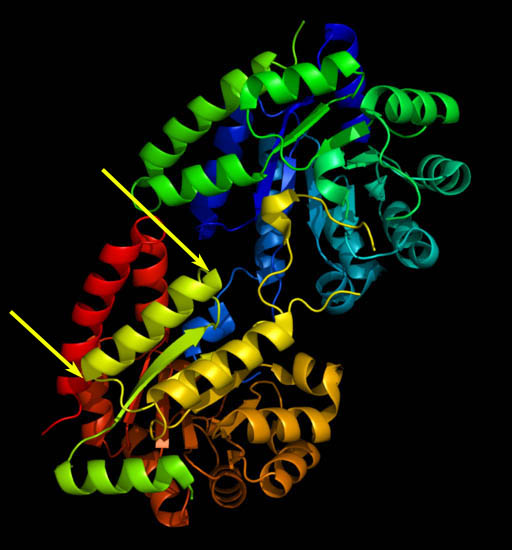 |
A cure for lack of reality: Find some images. If you do an image search for the protein Tryptophan Synthetase, one image you will find is on the left. It looks kind of like the pasta called spiralini which are spiraled or coiled. When certain amino acids connect to each other, they naturally form these coils (helixes). Each turn is about 3.5 amino acids. This is one way amino acids create a 3 dimensional protein that is capable of manufacturing other amino acids. I've put arrows pointing to the ends of the yellow-green helix. Question 5: About how many amino acids are in that helix?
|
|
Pitfall 2: Lack of Reality of the subject.
Cure: Find some pictures.
Amino acids are made from carbon, hydrogen, oxygen, and nitrogen. A few use sulfur. This is a model of Tryptophan Synthetase where we see the atoms of oxygen (red), nitrogen (blue), and carbon (greenish). The hydrogen atoms are not shown. This is what the surface would look like. Now roll over it to see the ribbon diagram. The ribbon diagram gives you a better view of what the internal connections and structure looks like. You can tell that these pictures gives you a better grasp of this protein than that long chemical name above. Question 6: How would use the Internet to find images of Tryptophan Synthetase?
|
|
Question 7: What is the purpose of having a chemistry lab class? |
|
Moving at too steep of a pace.
A book like "Chemistry for Dummies" is actually for people who are smart about their learning. Smart learners know to begin with the materials that start very basic then move on to tackling the harder material.
Back in college I was doing a research paper on some of Einstein's theories. I was smart to go to the children's section of the library. I found some great books that gave a good introduction to his theories. Then I was better prepared to read the more advanced books. Another way to start basic is to go back in time and see how chemistry was done with simple tools. One person who specialized in that is Kevin Dunn who as a website at called Caveman Chemistry. Visit his home page http://www.cavemanchemistry.com/ , read the first two introductory paragraphs (starts with "Half a million years ago...", and answer the following question.
Question #8: How are photographs made using cave man chemistry?
|
|
Question #9: In the first paragraph of the Caveman Chemistry introduction, it said, "Kingdoms rose and fell by the power of saltpeter, sulfur, and charcoal." The "power" of these chemicals comes from the fact they make gunpowder. Saltpeter is a salt of potassium nitrate (KNO3). Remember a salt is made from a metal combined with a nonmetal. In this case potassium is the metal and nitrogen and oxygen (NO3) are the non-metals. So we see why "salt" is in saltpeter, but why is "peter" in the name saltpeter? (Hint: Look up saltpeter at www.dictionary.com and find out the origin of the word). |
|
Question #10: Again, what are some of the symptoms you can experience if you go by words you don't know. |
 |
Thanks for doing the quiz. Just email your answers (questions and answers if you wish) to chm151@chemistryland.com
|
| Return to Succeed in Chemistry Menu |
